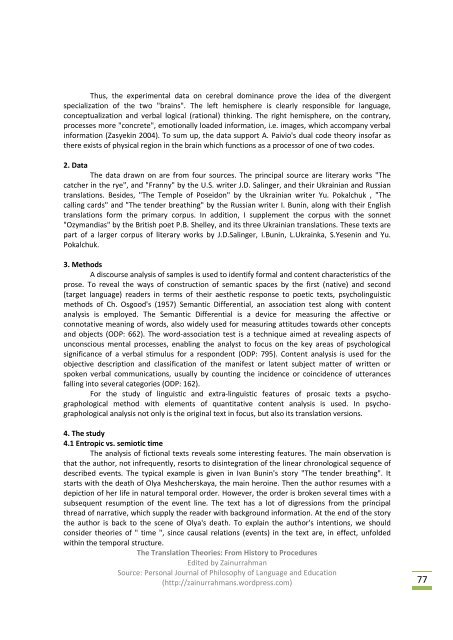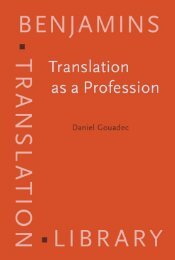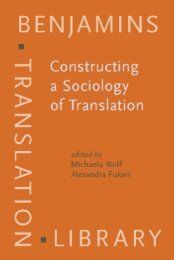Translation Theories.pdf
Translation Theories.pdf
Translation Theories.pdf
You also want an ePaper? Increase the reach of your titles
YUMPU automatically turns print PDFs into web optimized ePapers that Google loves.
Thus, the experimental data on cerebral dominance prove the idea of the divergent<br />
specialization of the two "brains". The left hemisphere is clearly responsible for language,<br />
conceptualization and verbal logical (rational) thinking. The right hemisphere, on the contrary,<br />
processes more "concrete", emotionally loaded information, i.e. images, which accompany verbal<br />
information (Zasyekin 2004). To sum up, the data support A. Paivio's dual code theory insofar as<br />
there exists of physical region in the brain which functions as a processor of one of two codes.<br />
2. Data<br />
The data drawn on are from four sources. The principal source are literary works "The<br />
catcher in the rye", and "Franny" by the U.S. writer J.D. Salinger, and their Ukrainian and Russian<br />
translations. Besides, "The Temple of Poseidon" by the Ukrainian writer Yu. Pokalchuk , "The<br />
calling cards" and "The tender breathing" by the Russian writer I. Bunin, along with their English<br />
translations form the primary corpus. In addition, I supplement the corpus with the sonnet<br />
"Ozymandias" by the British poet P.B. Shelley, and its three Ukrainian translations. These texts are<br />
part of a larger corpus of literary works by J.D.Salinger, I.Bunin, L.Ukrainka, S.Yesenin and Yu.<br />
Pokalchuk.<br />
3. Methods<br />
A discourse analysis of samples is used to identify formal and content characteristics of the<br />
prose. To reveal the ways of construction of semantic spaces by the first (native) and second<br />
(target language) readers in terms of their aesthetic response to poetic texts, psycholinguistic<br />
methods of Ch. Osgood's (1957) Semantic Differential, an association test along with content<br />
analysis is employed. The Semantic Differential is a device for measuring the affective or<br />
connotative meaning of words, also widely used for measuring attitudes towards other concepts<br />
and objects (ODP: 662). The word-association test is a technique aimed at revealing aspects of<br />
unconscious mental processes, enabling the analyst to focus on the key areas of psychological<br />
significance of a verbal stimulus for a respondent (ODP: 795). Content analysis is used for the<br />
objective description and classification of the manifest or latent subject matter of written or<br />
spoken verbal communications, usually by counting the incidence or coincidence of utterances<br />
falling into several categories (ODP: 162).<br />
For the study of linguistic and extra-linguistic features of prosaic texts a psychographological<br />
method with elements of quantitative content analysis is used. In psychographological<br />
analysis not only is the original text in focus, but also its translation versions.<br />
4. The study<br />
4.1 Entropic vs. semiotic time<br />
The analysis of fictional texts reveals some interesting features. The main observation is<br />
that the author, not infrequently, resorts to disintegration of the linear chronological sequence of<br />
described events. The typical example is given in Ivan Bunin's story "The tender breathing". It<br />
starts with the death of Olya Meshcherskaya, the main heroine. Then the author resumes with a<br />
depiction of her life in natural temporal order. However, the order is broken several times with a<br />
subsequent resumption of the event line. The text has a lot of digressions from the principal<br />
thread of narrative, which supply the reader with background information. At the end of the story<br />
the author is back to the scene of Olya's death. To explain the author's intentions, we should<br />
consider theories of " time ", since causal relations (events) in the text are, in effect, unfolded<br />
within the temporal structure.<br />
The <strong>Translation</strong> <strong>Theories</strong>: From History to Procedures<br />
Edited by Zainurrahman<br />
Source: Personal Journal of Philosophy of Language and Education<br />
(http://zainurrahmans.wordpress.com) 77

















